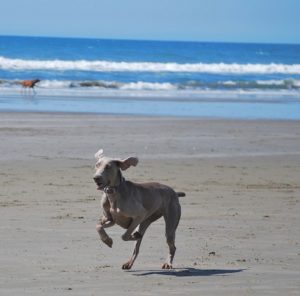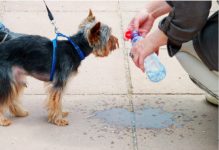With the warm summer months just around the corner, you and your pet will soon be enjoying the sunshine and outdoors together. But higher temperatures can increase the risks of dehydration, injuries, and even heat stroke. Before you head out for summer fun, take the necessary steps to keep your pet safe, healthy and happy this season.
Safe Pet Food Storage
The change in weather can result in more ants and other insects entering your home, which increases the risk of insect infestation of open packages of pet food and treats. Proper pet food and treat storage can help preserve the nutritional quality, and is critical to avoid common pet food pests. Some guidelines to keep the bugs out include:
- Check pet food packaging at the store. Inspect packaging carefully for rips or tears that may have occurred during transport. Also, ensure that the package is still properly sealed.
- Once you’ve brought the item home, review any storage guidance provided by the manufacturer. In general, dry foods and treats should be stored off the floor, and in a cool, dry location. Once a bag of dry pet food has been opened, it should be stored in a tightly sealed container. Open cans or packets of wet and fresh food should be kept sealed or covered and refrigerated.
- If insects are found in the food or treat package after you’ve brought them home, you should contact both the retailer and the manufacturer.
 Dehydration
Dehydration
Don’t forget that water is an essential nutrient for our dogs and cats, and they need a constant supply of fresh water in order to maintain essential body functions. Here are some ways to keep your pet hydrated, especially in the warm summer months:
- Keep your pet’s water bowl replenished regularly with fresh water.
- Many cats especially love moving water. If your cat is not drinking from a water bowl, try leaving a dripping faucet on or purchase a water fountain that will encourage your cat to drink water.
- If you’re hitting the road this summer for vacation, be sure to take plenty of water with you and let your dog out for bathroom breaks whenever necessary.
- With warmer temperatures, your dog can become thirsty more quickly with any activity. Make sure to bring a portable water bowl with you on all your summer outings, including walks around the block, jogs through the neighborhood, or playtime at the dog park.
- At the beach, don’t allow your dog to drink the salty ocean water. Too much salt, like humans, is not good for their health. Bring your own water from home and a bowl to give your pet a drink at the beach.
- Symptoms of dehydration can include sunken eyes or loss in appetite. If your pet is experiencing dehydration, take them to a vet, who can provide additional fluids and medical support.
Heat
In the summer, temperatures can heat up quickly and be harmful to your pet. In addition to keeping your pet hydrated, consider these safety precautions to keep your pet safe and cool.
- The summer sun can cause the pavement to become extremely hot. Hot pavement can damage your dog’s paw pads. Prevent damage by checking the temperature of pavement before you walk – if it is too hot for you to be barefoot on, it is too hot for your pet. When pavement is too hot, try to stay on the grass or consider dog shoes or peel and stick paw pads.
- Just like humans, dogs can suffer from heatstroke, too. Symptoms can include excessive panting, weakness or dizziness, pale gums or excessive salivation. If you believe that your dog is suffering from heatstroke, work to cool them down (such as placing cold wet towels on them) and take your pet to the vet immediately. Remember that certain factors, such as obesity or old age, can increase your dog’s risk for heatstroke. Budget their time outdoors in the heat accordingly.
- Never leave your dog in a parked car in warm weather, even if you are in the shade or leaving the pet alone for just a few minutes. The interior of the car can become significantly warmer than the outside temperature after just a few minutes and poses a risk to your pet’s life. Even if you are just running a quick errand, leave your dog in your air-conditioned house.
- During outdoor activities, including walks, festivals and other outings, take frequent breaks with your pet and find a shady spot to relax out of the sun.
- Yes, even pets can get sunburns! If your dog is a hairless breed or has especially short or light hair, you may want to consider pet-specific sunscreen.
 Exercise
Exercise
With warmer weather, there are many more opportunities to stay active with your pet. Walking, running, swimming, playing at the dog park and trips to the beach are all great summer activities for you and your pet. Exercise is a vital component of your pet’s overall well-being. Keep these safety tips in mind while you get out with your pet this summer:
- Consider the timing of your walks and other activities. The temperatures are much cooler in the early morning and late evening hours. But remember to take frequent breaks in the shade and bring water with you, no matter what time you head out of the house.
- Not all dogs know how to swim. And even some that do may struggle on getting out of the pool, lake or river. Purchase a life vest for your dog and put it on them during water activities, such as swimming, boating and sailing. Always keep a close eye on your pet when near water.
- If you’re a jogger, always warm up your pet with a 10-minute walk prior to speeding it up to a jog or run. You should also allow time for cool-down and recovery when you’ve completed your activity.
- Before letting your pet off the leash at the beach, check for sharp objects and hidden dangers. Beaches can have coral, shells and jellyfish which can injure your pet’s paws. When you head back home, double-check your pet’s feet for any injuries.
- Consult your veterinarian if you’re starting a new exercise routine to ensure your pet is healthy enough for the exercise you have planned.
Potential for Toxic Foods
Summertime means more cookouts with family and friends. While you may enjoy the food at the family barbeque, keep in mind that many foods humans eat are toxic to pets. Consumption of the following items can be seriously harmful to your pet, causing symptoms such as vomiting, anemia, irregular heart rhythm and seizures:
- Chocolate
- Avocado
- Garlic and Onions
- Grapes and Raisins
- Macadamia Nuts
- Hops (fresh and cooked)
- Alcohol
Also, remember to never feed your pet table scraps. It’s tempting to want to show them you care for them with a treat from the table, but many of the foods we eat can cause more harm than good. Instead, give your pet a special treat or chew made specifically for your pet. When we treat responsibly and keep an eye on table scraps, we can help our pets remain happy and healthy year-round.



